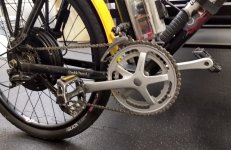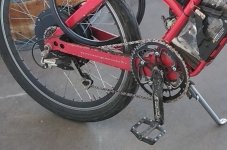regarding gearing...if the sa igh is like any of the ones i've held in my hands, 14t is probably the smallest you could fit for one.
you can get a bunch of sizes here int this randomly found sa 3speed sprocket search
https://www.wheelandsprocket.com/product/sturmey-archer-3-speed-sprocket-and-circlip-245383-1.htm
and 14t is smallest they carry probably for that reason.
Option UPC Store SKU
18t / dished 1/8" 04710944237603
20t / dished 1/8" 04710944239010
22t / dished 1/8" 04710944238518 STU33822520G
24t / dished 1/8" 04710944245141
14t / flat 1/8" 04710944228724
16t / flat 1/8" 04710944236903
18t / flat 1/8" 04710944236927
20t / flat 1/8" 04710944238952
22t / flat 1/8" 04710944238969
14t / flat 3/32" 04710944238976
16t / flat 3/32" 04710944228748 STU35573555G
18t / flat 3/32" 04710944238983
20t / flat 3/32" 04710944238990
22t / flat 3/32" 04710944239003
it would require a custom made adapter and axle spacers / custom dropout spacing with torque clamps to make a sort of top-hat shaped adapter to go from the diameter of the sprocket mount on the igh out to over the axle itslef, with a bearing inside it to support it on the axle surface, then down in diameter enough to fit the inside of a 10t sprocket.
most cassettes and freewheels only go down to 11t, so even if you have one of the combo type ighs that has a cassette freehub *and* internal gearing, you still can probably only put 11t on it.
if it's got a threaded spot for a regulard freewheel instead of freehub splines, there are cheaply-made 10t freewheels that should fit on that.
https://www.google.com/search?q=10t+sprocket+freewheel
edit, was wron,g, the one i'm thinking of is 12t
https://endless-sphere.com/forums/viewtopic.php?f=2&t=67833&p=1237062
can't find a 10 except on a verys pecific regular bike hub, no gearing inside it. no freewhel eaither, is ifxed so chain would always move whether pedalling or not.
recumpence made one on a jackshaft
https://endless-sphere.com/forums/viewtopic.php?f=28&t=22483
but that's not what ou're after.
however, all small gearing like that wears out quickly, vs larger sprockets, so you may end up replacing it frequently. not as frequently with just pedal power as with motor power, but still more than if you used larger ones.
as for crankset ring size--you would have to meausre the distance between the chainstay as it angles out between bb and dropout, and the intersection plane of the largest ring on your crankset. as long as the diameter of that plane before intersection allows for a ring with as many teeth as your'e after, then you can use one that big. otherwise you're limited to a smaller one.
alternately, if your hips and knees can handle the extra strain, or you have wide hips to start with, then you can use a wider crankshaft to put your rings farther away from the frame, which increases the size of chainring you can use
a check of the surly page for that bike says
Max Chainring (CL)[3]
1x (Road): 50T
2x (Road): 39/53T
under the frame specs, meaning i fyou use a two ring rankc of that type it'll go up to 53t



